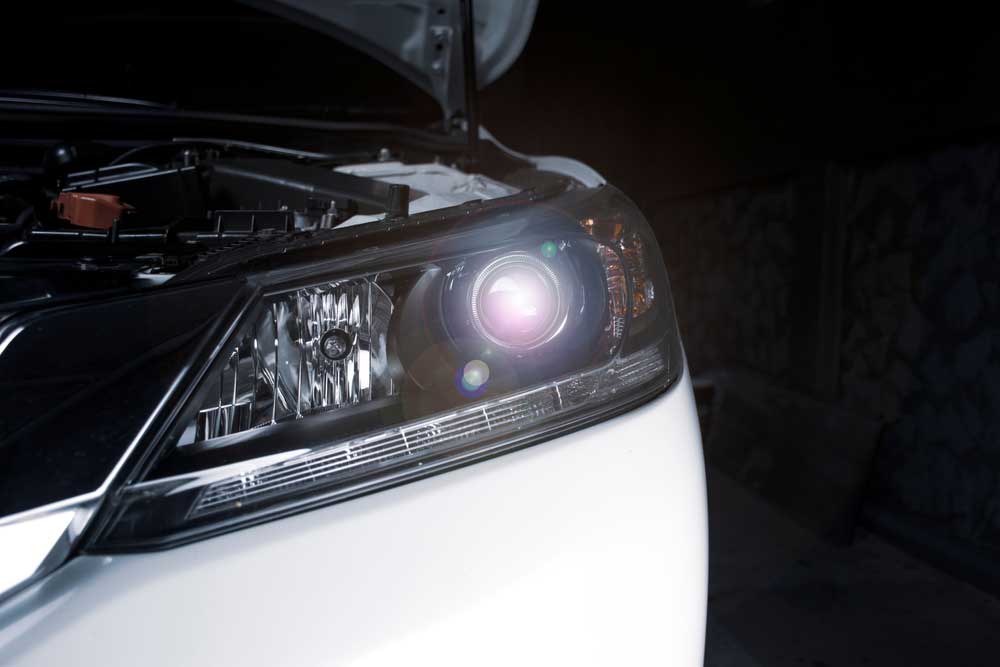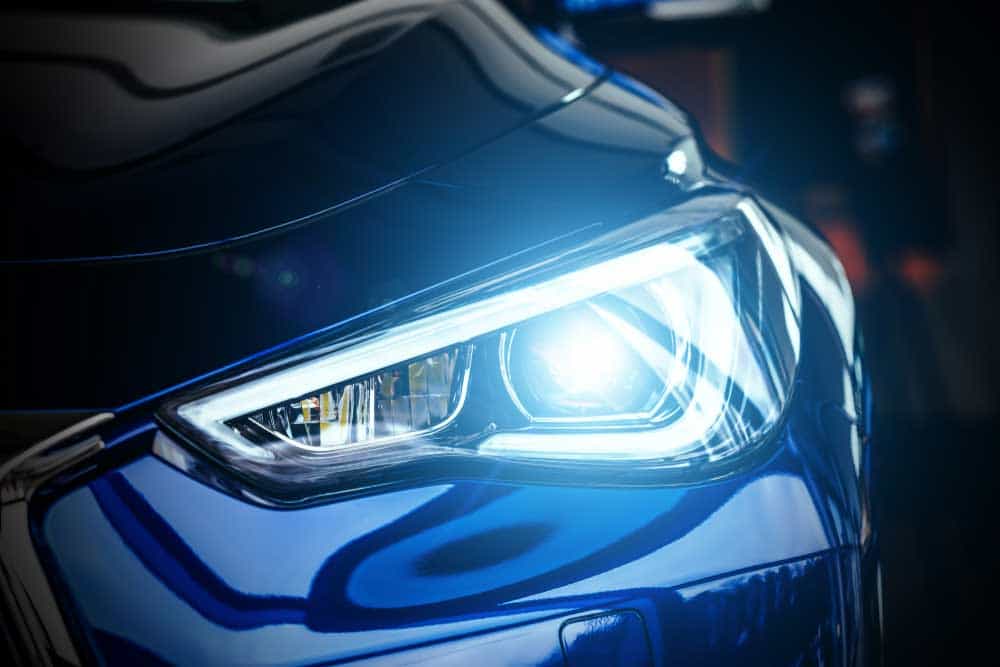Headlights are vital components of a car that boost drivers’ chances of safely arriving at a destination in darker conditions. Hence, putting more thought into them before upgrading or getting new headlights is crucial. Headlights are similar to lighting fixtures. And several lighting technologies can make them, but each headlight has different benefits. This article will compare two headlighting giants: HID vs. LED. Further, we’ll help you answer the big question: What are these, and which is better?
Also, you’ll learn about how to replace these lights and more.
Let’s go!
HID vs. LED: Definition
What are HID Headlights?

HID Headlights
High-intensity discharge (HID) headlights are lighting technologies that emit light when exposed to heat. These lights combine gas and rare metals to give a white-tinted glow and bright blue hue when you tell the filament to heat.
Also, you can call them Xenon headlights. The main advantages of HID headlights include:
- Excellent energy efficiency
- Higher lifespan than Halogen lights.
- Three times brighter than most halogen lights.
- Reduced glare from approaching traffic.
HIDs are great, but let’s see how they compare to the more powerful LED headlights.
What are LED Headlights?

Silver headlight
Light-emitting diode (LED) headlights don’t need gas or filaments. Instead, they use semiconductors to move current that emits photons. Then, the photons help to create light. LED headlights offer the following main benefits:
- LED headlights are smaller and less bulky than other headlighting technologies.
- They offer the ultimate energy efficiency.
- They also don’t produce as much heat as other lighting technologies.
- LED headlights have long lifespans.
- They give impressive illumination to the sides of the road.
Types of HID and LED Headlights

Car bulb
You can get two types of LED and HID headlights. These types include dual-beam and low-beam.
Dual-Beam

Dual-beam headlights
Dual beams are multifunctional as they come in one unit with low-beam and high-beam functions. So, if your vehicle provides space for only one headlight on each side, the dual-beam is a fantastic choice.
Also, you can switch from high to low to fit your purpose. Manufacturers usually label these bulbs as H13, 9007, H4, and 9004.
Single-Beam

SIngle-beam Headlights
In contrast, cars that provide two headlight spaces (on each side) will need single-beam options. These headlights need separate units for the high-beam and low-beam lights. Hence, turning on the high beam will switch off the low beam, and vice versa.
HID vs. LED: The Difference
Here’s a table comparing HID and LED headlights:
| Feature | LED | HID |
| Lifespan (hours) | 45,000 | 15,000 |
| Fading | No | Yes |
| Installation | Easy to install | It ranges from easy to medium installation. |
| Light source | Diodes (electricity) | Xenon gas, and filaments. |
| Best application | Reflector headlights | Projector headlights. |
| Fast warm-up time | Instant turn-up | Yes, but with a short lag. |
| Installation time | Up to 20 minutes | Up to 30 minutes. |
| Light distance | About 300 meters. | About 300 meters. |
| Energy efficiency | Maximum efficiency (85% lower energy consumption than halogen). | High efficiency (75% lower energy consumption than halogen). |
| Available colors | All colors. | All colors. |
| Heat emission | Low heat emission. | High heat emission. |
Size

Man holding headlight
LEDs offer a more compact lighting option than HID headlights. However, you’ll need conversion kits before installing any of the lights. If you prefer HID lights, we recommend getting a plug-and-play kit with everything you need to install your new HID bulbs easily.
In contrast, some LED headlights have similar shapes to halogen headlights. And they fit into headlight sockets without needing extra tweaking like HIDs.
HID vs. LED: Brightness

Bright headlight
Brightness is one of the most significant factors to consider before choosing headlights. It determines how much light your bulbs will generate. Generally, HID headlights offer more coverage range than LED headlights.
However, they may reflect glare on approaching traffic if you don’t install them correctly.
On the other hand, LED headlights offer more coverage to the side. And, they have more precision to avoid reflecting glare, making it a bit easy to travel on darker nights.
Lifespan and Durability

Man checking headlight
Compared to halogen bulbs, LEDs and HID headlights offer a new level of durability. However, LEDs take the win in this category.
Because of their designs, LEDs offer the most extended lifespan for automotive headlights. They can last up to 45,000 hours and will only stop working when the power stops flowing to their diodes. It’s a problem caused mainly by damage, corrosion, heat, or old age.
On the other hand, HIDs are pretty durable too. But because of their design, the gas responsible for the light eventually runs out. Notwithstanding, HIDs can last up to 15,000 hours.
Compared to LEDs, HID headlights don’t stop working abruptly. Instead, they dim slowly as the gas runs out.
HID vs. LED: Colors
Color temperature is a crucial factor that affects visibility and brightness. Although LED headlights offer several colors, finding a retailer that sells conversion kits in other colors might be challenging.
Similarly, HID lights offer several colors that are easier to get. Usually, you can get HID headlights in seven color temperatures, including
- Purple blue (12,000K).
- Pure blue (10,000K).
- Ice blue (8000K).
- Bright white (6000K).
- Alpine white (5000K).
- Pure white (4300k).
- Golden yellow (3000K).
Note: Brighter HID headlights are between 4300K to 6000K.
LED vs. HID: Bulb Design

LED headlight bulb design
An LED headlight bulb’s design has a heat sink at the base, a long narrow stem at the top, and locking tabs in the middle. In short, LEDs have simpler designs than HIDs.
In contrast, HIDs have a quartz chamber filled with electrodes and base locking tabs. Usually, these are separate components connected to the bulb. However, HIDs need an ignitor and ballast to function correctly.
Heat Emission
Undoubtedly, LEDs have lesser heat emissions than HID headlights. They run cooler because heat is not necessary for light production. Instead, they rely on power and the heat sink that promotes cooling.
On the other hand, HIDs generate more heat because it’s necessary for light production. However, most drivers in cold regions prefer HIDs because they are hot enough to melt snow off the headlights.
Energy Efficiency
LEDs offer more energy efficiency than HIDs. They can convert 90% of their energy into light. HIDs also feature impressive energy efficiency as they can convert 70 to 80%.
How Do You Replace/Install LED and HID Headlights?
Each vehicle comes with specific instructions for headlight installation. Usually, it depends on the year and model of your car and the headlights you purchase. Although many conversion kits are plug-and-play systems, others may take up to 30 minutes.
Therefore, we recommend following the instructions for your headlights carefully before DIY installation.
Note: Always contact your repair guide or owner’s manual before attempting any repairs.
FAQs
What is better: HID or LED?
It depends. They both have specific areas they work excellently. However, LED is better overall.
HID vs. LED vs. Halogen
Both HID and LED headlights are better than halogen.
HID vs. LED Grow lights
LED grow lights are better overall. However, HID grows lights are great alternatives if you can’t deal with the high upfront cost of LEDs.
Rounding Up
HID and LED headlights to offer impressive vision while driving in dark conditions. Though they have their differences in cost and production, you’ll have a safe field of vision with both auto lighting options.
LEDs may be more expensive upfront, but they’re more cost-effective in the long run. HID headlights have lesser upfront costs, but the maintenance is costly in the long run.
Do you have any questions? Feel free to contact us, and we’ll be happy to help.
